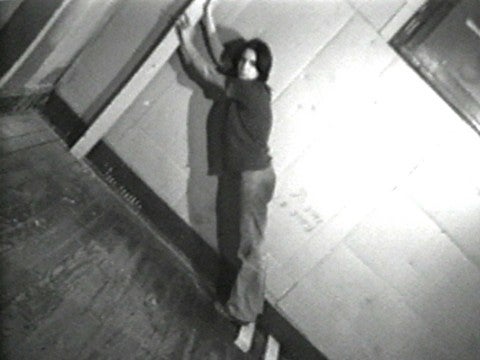Rita Myers is one of the pioneers of video installation art. Her early works from the 1970s showcase her embrace of minimalism and performance and a desire to utilize video, the newest technology of the time, as a time-based pictorial element. In later works, Myers drew from a range of sources, including magic, physics, alchemy, and Jungian psychology, to create symbolic environments and contemplative sites that explore nature versus technology.
Born in 1947 in Hammonton, New Jersey, Myers earned a BA from Douglass College, Rutgers University, in 1969, and an MA from Hunter College, CUNY, in 1974. She has had solo shows at The Kitchen, Whitney Museum of American Art, and Art Gallery of Ontario. In 1985, she exhibited her work at the São Paulo Biennial. Her various grants and fellowships include those from the National Endowment for the Arts, Creative Artists’ Public Services (CAPS), the New York State Council on the Arts, and the Jerome Foundation, and she won the 10th World Wide Video Festival Prize in The Hague, the Netherlands, in 1992. Since 1977, she has been an art educator, teaching at numerous institutions, including Douglass College, Carnegie Mellon University, MIT, the University of Hartford, and the Cooper Union School of Art.
Myers’s early works include playful, reflexive uses of video and closed-circuit monitoring, such as Slow Squeeze (1973), in which Myers squeezes her body to “fit” within the shrinking frame of a gradual camera zoom. Jumps (1973) also explores the line between real-time technology and human gesture: Myers attempts to escape the space of closed-circuit monitoring by jumping out of its view. As the frame widens, she continually jumps to defy the camera’s gaze.
In the late 1970s and early 1980s, Myers’s artwork presented mystical worlds and landscapes of her own invention through video installation. Barricade to Blue (1977) is a metaphorical landscape produced by television monitors. The blue light of the screens floods two congruent spaces of the gallery, evoking various associations with the color, such as “the aroused blue of sexuality...the blue of cold and dying...the transitional blues of the body passing into a state of bliss.” Myers describes Dancing in the Land Where Children Are the Light (1981), another landscape of curved paths and crushed glass in which metal plates and monitors are suspended, as “a landscape of fiction, a world out of time, a world which has escaped the constraints of physical law.” The Eye of the Beast is Red (1983) further evokes a supernatural site. It features four vine-covered video monitors “planted” in the floor with a swinging obelisk overhead.
Like previous works, the experience of The Eye of the Beast is Red seems to lie somewhere between the real and the imaginary. Myers would expand on these pieces by using video to construct analogies with myths, symbols, and rituals throughout the 1980s. In the Planet of the Eye (1984) features a fast-paced collage of imagery set to a rhythmic soundtrack. It shows Myers’s translation of ancient cosmological, mythical symbols, and archetypes into technological artifacts. Rift Rise (1986), Myers writes, represents the “the mutual exchange of catastrophe and renewal, rupture and harmony…. [It reflects the] destructive force, its inevitability, and its ultimate symbiosis with deeper cycles of being, as the inextricable link between decay and regeneration.” Images of destruction, conflagration, and renewal appear on three video monitors set in a circle of black stone slabs, opposite three parallel monitors hanging from birch trees.
Myers later related technological products and processes to a much more personal experience. Inspired by Christoforo Simone dei Crocefissi’s painting The Dream of the Virgin (ca. 1350), as well as the death of Myers’s father to a long, dreadful illness, she created Resurrection Body in 1993. The installation consists of a nude male performer lying on a large bed from which three large trees containing several monitors sprout. Cardiac and biofeedback sensors are attached to the man and the small forest surrounding him, which, depending on his physical activity, generate images of either an electrocardiogram or portraits of Myers’s family. According to Myers, “Resurrection Body is a meditation on the dying, dreaming body... [It] attempts to locate the human body as a site for the expression of destabilized and reconstituted meanings.”
Twenty years earlier, Myers effectively destabilized and reconstituted her own body in Tilt 1 (1973). As in her early performance exercises, Myers uses her body to investigate the tension between imagined space and the actual space she inhabits. She begins by leaning against a wooden post to negotiate her relationship to the frame of the camera as it gradually shifts in a clockwise movement that turns the room sideways. Myers adjusts her position and then balances herself with increasing difficulty against the column and wooden blocks attached to the floor.
Between each shift of the camera angle, Myers returns to her natural posture to regroup before attempting the next challenge, and the action highlights the contrast between reality and the camera’s view. Beyond the experimental nature of this early form of video art, Myers’s struggle to appear upright and comply with the view of the camera speaks to the ways in which people adjust their images and strive to create certain portrayals of themselves in media, such as videos, photographs, and social networks. Tilt 1, in a very rudimentary manner, might be seen as foreshadowing the complex landscape of tweets, filters, and status updates that people now navigate in daily life. —Kanitra Fletcher

